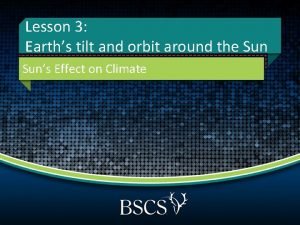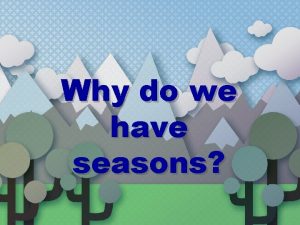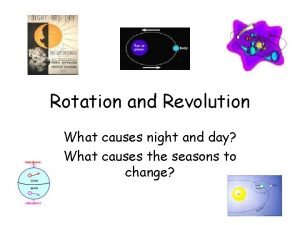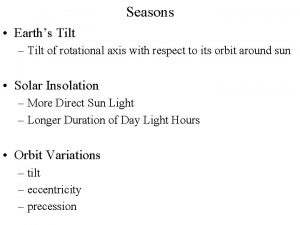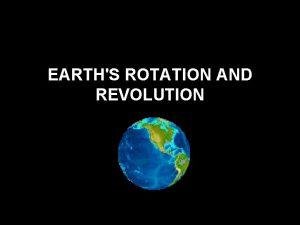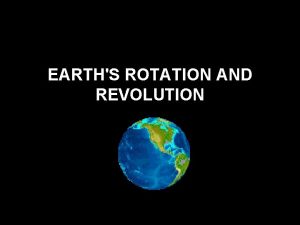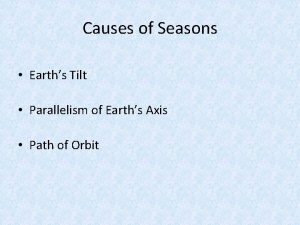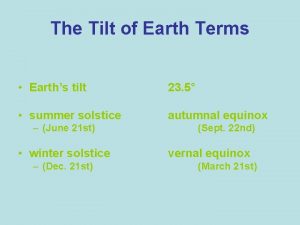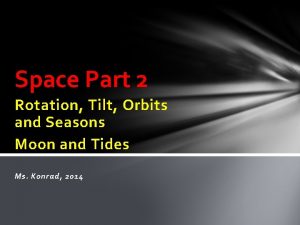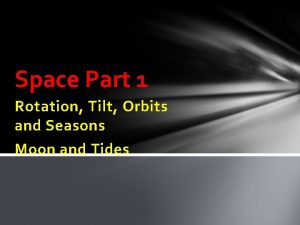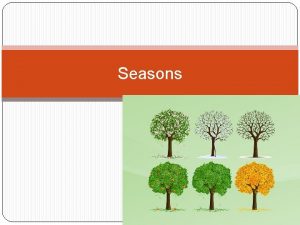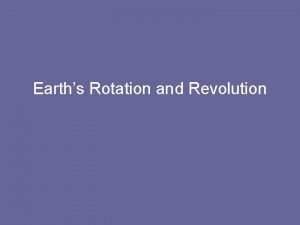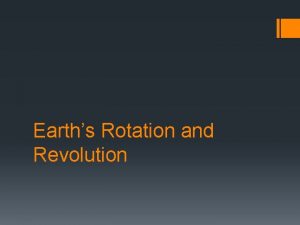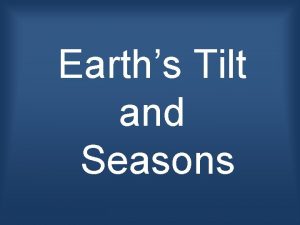The Seasons and Earths Tilt Mindson Earths Rotation



















- Slides: 19

The Seasons and Earth’s Tilt • Minds-on • Earth’s Ø Rotation Ø Tilt Ø Revolution • Inquiry Activity • Direct vs. Indirect Sunlight • The Seasons • Inquiry Lab

Minds-on Seasons 1. Why is it cold in the winter and hot in the summer? 2. What about places near the equator? Why is there temperature pretty much constant throughout the year?

Average Temperature for Pontianak Indonesia Equator What do you notice? http: //www. worldweatheronline. com/v 2/weather-averages. aspx? q=Pontianak, %20 Indonesia

Effects of Earth’s Rotation: • Rotation: spinning of an object around its axis • One rotation of Earth takes 24 hours

Effects of Earth’s Rotation: • Earth’s rotation causes half the planet to face towards the sun (day) and the other half away (night) at all times

Earth’s Tilt • Earth is slightly tilted on it’s axis (23. 5 o) main cause of the seasons. • Why?

Effect of Earth’s Revolution: • Revolution: movement of one object travelling around another • Takes Earth one year to travel in a circle around the Sun • Allows us to see different constellations during different seasons • Causes the tilt to create the seasons, why?

Tilt + Revolution = Seasons • Use the diagram below to explain how the tilt and revolution of the earth around the sun causes the seasons.

Minds-on Revisit 1. Why is it cold in the winter and hot in the summer? 2. What about places near the equator? Why is there temperature pretty much constant throughout the year?

The Tilt! • The seasons are caused by the Earth’s tilt (23. 5 °) • The tilt of the Earth causes different parts to receive different amounts of direct sunlight – People on the equator receive approximately the same amount of direct sunlight all year. Therefore, their temperatures are mostly constant throughout the year. Eureka!!

Computer Activity Seasons: What is your current latitude? _______ 1. Open the simulation below by clicking the picture 2. Place your person at the proper latitude (vertical) 3. Observe how the light strikes our person during January, March, July, and September 4. Sketch your observation (see example) in the space provided on the next slide and include the average temperature for your city during those months

Sketch January March July September

Direct Sunlight North America in January North America in July What do you notice?

• The more direct sunlight an area gets the warmer it is – In what season is North America tilted towards the Sun? – In what season is North America tilted away from the Sun? – In what season(s) does the tilt not really affect temperature?

The Seasons • In North America it is summer in June, July and August and winter in South America because – In June, July and August North America is tilted towards the Sun (more direct sunlight) and South America is tilted away from the sun (less direct sunlight)

Inquiry Activity 1. Open the animation by clicking the image 2. Make the Inclination Angle 23° (angle of Earth’s tilt) and click trace the Sun’s path 3. Record your observations of the Average Daily Temperature and the Sun’s path (sketch) for both winter and summer in your notebook. Use the example on the following slide.

Summer vs. Winter Summer Winter What do you notice? What does the Sun’s path effect? (hint: time & angle)

Summer vs. Winter • In Winter, the Sun doesn’t get as high in the sky and therefore, we see it for less time (shorter days) and we receive less direct sunlight (colder) • In Summer, the Sun takes a much longer path across the sky and therefore, we see it for more time (longer days) and we receive more direct sunlight (hotter)

Bill Nye: Seasons
 What does the earths tilt cause
What does the earths tilt cause What does earths tilt do
What does earths tilt do Earths orbit seasons
Earths orbit seasons Why do we have seaosns
Why do we have seaosns What causes night and day? *
What causes night and day? * There are two seasons in a year true or false
There are two seasons in a year true or false Optically active examples
Optically active examples Head tilt chin lift and jaw thrust maneuver is used for
Head tilt chin lift and jaw thrust maneuver is used for What is gag reflex mean
What is gag reflex mean Transparency in learning and teaching
Transparency in learning and teaching Advantages of stationary container system
Advantages of stationary container system Jenna
Jenna Bao kaynakları
Bao kaynakları Anjioektazi
Anjioektazi Head tilt chin lift jaw thrust
Head tilt chin lift jaw thrust Cab cpr meaning
Cab cpr meaning Tilt frame container system
Tilt frame container system Head tilt chin lift jaw thrust
Head tilt chin lift jaw thrust Head tilt chin lift jaw thrust
Head tilt chin lift jaw thrust Rumus kurtosis dan skewness
Rumus kurtosis dan skewness

